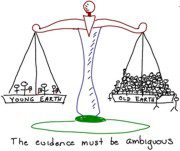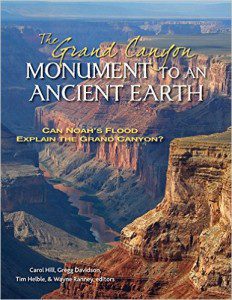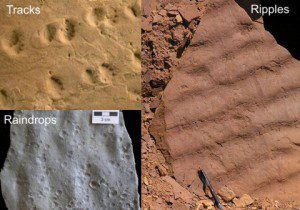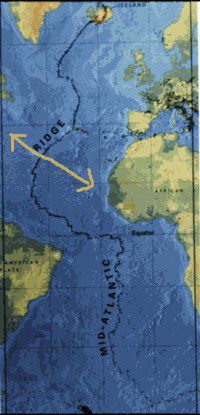(Image from Wikipedia: credit)
 The evidence for an ancient earth – far, far older than the <10,000 year timeline defended in young earth creationism – is abundant and independent of any hypothesis concerning the mechanism of biological evolution. There are only two reasons to doubt the great age of the earth: (1) an ignorance of the data or (2) a prior commitment to a young earth (usually from a specific approach to Genesis). In my experience, adamant defense of a young earth has always been tied to the bible. The necessary result of any investigation of geological features is thus predetermined. The data must fit this model. But, the data does not really fit the model.
The evidence for an ancient earth – far, far older than the <10,000 year timeline defended in young earth creationism – is abundant and independent of any hypothesis concerning the mechanism of biological evolution. There are only two reasons to doubt the great age of the earth: (1) an ignorance of the data or (2) a prior commitment to a young earth (usually from a specific approach to Genesis). In my experience, adamant defense of a young earth has always been tied to the bible. The necessary result of any investigation of geological features is thus predetermined. The data must fit this model. But, the data does not really fit the model.
 I’ve been reading a new book that uses the geology of the Grand Canyon region to outline the evidence for an ancient earth, The Grand Canyon, Monument to an Ancient Earth: Can Noah’s Flood Explain the Grand Canyon? This book contains abundant pictures and diagrams to educate the reader about geology and the shortcomings of flood geology. Most of the authors are Christian and all are experts in the science contained in their respective chapters. Interestingly, I once shared a shuttle with two of them from Boston airport to Gordon College. Despite the fact that four Christian science professors (a geologist, a paleontologist, a chemist and a biologist) were in the van, the driver shared that he was convinced that science disproved Christianity, with evolution and the age of the earth at the top of his reasons.
I’ve been reading a new book that uses the geology of the Grand Canyon region to outline the evidence for an ancient earth, The Grand Canyon, Monument to an Ancient Earth: Can Noah’s Flood Explain the Grand Canyon? This book contains abundant pictures and diagrams to educate the reader about geology and the shortcomings of flood geology. Most of the authors are Christian and all are experts in the science contained in their respective chapters. Interestingly, I once shared a shuttle with two of them from Boston airport to Gordon College. Despite the fact that four Christian science professors (a geologist, a paleontologist, a chemist and a biologist) were in the van, the driver shared that he was convinced that science disproved Christianity, with evolution and the age of the earth at the top of his reasons.
My first post on this book (A Grand Canyon) looked at Part 1: Two Views, a comparison of the time frames of flood geology and modern geology. Today we turn to Part 2: How Geology Works. This chapter is a brief primer on the basics of geology and dating. Three chapters explore the structure and formation of different types of sedimentary rock, three chapters explore the methods used to date the different layers of rock observed in the Grand Canyon and elsewhere and the final two chapters provide an introduction to plate tectonics and the evidence for the motion of plates left in the rock layers at the Grand Canyon and elsewhere around the world. If you have little or no scientific training, and have wondered how geology works and why the overwhelming majority of Christian geologists have little patience with Flood Geology this section is for you. It is informative and easy to read accompanied by great illustrations and pictures. In what follows I will focus in one one or two points from each of the three subsections.
 Sedimentary Rocks – The most impressive formations in the Grand Canyon result from water carving through layers of sedimentary rock of different color and composition. There is sandstone, limestone and shale. These layers contain a number of fossilized clues the the past environment. Along with the more familiar shell and body fossils there are ripples from long gone wave or wind action, raindrops, ancient mudcracks, and trackways (Ripples image source, raindrops source Rygel, M.C., tracks source). These come in various strata throughout the canyon. The formation and preservation of such marks can be tested in the laboratory and compared with modern sites. High velocity currents will not produce fossilized ripples or allow for the preservation of raindrop splats or fine detail in trackways left by small animals. The evidence in the canyon supports repeated long cycles of immersion and drying-out. This is inconsistent with a violent year-long flood placing the layers.
Sedimentary Rocks – The most impressive formations in the Grand Canyon result from water carving through layers of sedimentary rock of different color and composition. There is sandstone, limestone and shale. These layers contain a number of fossilized clues the the past environment. Along with the more familiar shell and body fossils there are ripples from long gone wave or wind action, raindrops, ancient mudcracks, and trackways (Ripples image source, raindrops source Rygel, M.C., tracks source). These come in various strata throughout the canyon. The formation and preservation of such marks can be tested in the laboratory and compared with modern sites. High velocity currents will not produce fossilized ripples or allow for the preservation of raindrop splats or fine detail in trackways left by small animals. The evidence in the canyon supports repeated long cycles of immersion and drying-out. This is inconsistent with a violent year-long flood placing the layers.
 Geological Time – The layers of sedimentary rock with intrusions of igneous rock from below provide an excellent framework for determining the relative timing of the various layers of rock in the American Southwest and around the world. In the walls of the canyon there is evidence for ancient riverbeds eroding through various layers. The sketch to the right illustrates some of these features and the march of time that produces them. There are a number of photographs in the book (and a much larger range of better sketches) that illustrate the various phenomena present in the layers below the rim of the Grand Canyon. The sketch to the right is my own simplified rendition of some of the features and phenomena discussed.
Geological Time – The layers of sedimentary rock with intrusions of igneous rock from below provide an excellent framework for determining the relative timing of the various layers of rock in the American Southwest and around the world. In the walls of the canyon there is evidence for ancient riverbeds eroding through various layers. The sketch to the right illustrates some of these features and the march of time that produces them. There are a number of photographs in the book (and a much larger range of better sketches) that illustrate the various phenomena present in the layers below the rim of the Grand Canyon. The sketch to the right is my own simplified rendition of some of the features and phenomena discussed.
Although layering and fossils provide a robust relative timeline for the layers, and numerous features suggest a very long span of time for deposition of rock and then formation of the canyon, it is necessary to turn to other methods to establish absolute dates. Roger Wiens has provided a chapter with an excellent lay-level description of radiometric dating and the strengths and weaknesses of this method. Radiometric dating is a sophisticated method with samples tested in a variety of different ways. There are natural phenomena that can confound the results, but these are known, most are well understood, and they are controlled for. Wiens also considers some of the data put forward by YEC organizations to try to discredit radiometric dating. All of these represent misuse of the method or exhibit the normal range of error in scientific investigation.
Radiometric dating has proven to be accurate in dating ancient historical events such as the eruption of Mount Vesuvius. The same methods show that the Grand Canyon cannot be younger than a million years old, based on the age of lava that flowed into the gorge, and that some of the basement rocks into which the canyon was carved are more than one billion years old. (p. 97)
 Tectonics and Structure -The final two chapters by Bryan Tapp and Ken Wolgemuth provide a basic introduction to plate tectonics and examine a number of geological features traced to the influence of the motion of the earth’s crust. One interesting point of connection between radiometric dating and plate tectonics is found in the increasing separation of the North American and African plates. GPS measurements demonstrate a motion of about 1 inch per year today. Radiometric methods were used to date the lava that has welled up through the Mid-Atlantic Ridge. This rock is youngest near the ridge and oldest near the continents. Over 180 million years the rate of separation has averaged 1.2 inches per year with a range of about 1.1 to 1.7 inches/year.
Tectonics and Structure -The final two chapters by Bryan Tapp and Ken Wolgemuth provide a basic introduction to plate tectonics and examine a number of geological features traced to the influence of the motion of the earth’s crust. One interesting point of connection between radiometric dating and plate tectonics is found in the increasing separation of the North American and African plates. GPS measurements demonstrate a motion of about 1 inch per year today. Radiometric methods were used to date the lava that has welled up through the Mid-Atlantic Ridge. This rock is youngest near the ridge and oldest near the continents. Over 180 million years the rate of separation has averaged 1.2 inches per year with a range of about 1.1 to 1.7 inches/year.
Fractures, faults and folds throughout the Grand Canyon region testify to a number of different kinds of motion over the last 500 million years or so. The fractures demonstrate motion of solid compacted rock, with relatively little folding of softer sediment. This is powerful evidence against a flood active in the formation of the Canyon and the sedimentary layers through which it cuts. The evidence simply does not fit the necessary timeline. Violent plate tectonics a mere four thousand years ago would violate many different laws of physics. There simply is no evidence at the Grand Canyon or anywhere else for a recent global cataclysmic event shaping the crust of the earth.
The Grand Canyon, Monument to an Ancient Earth provides many more details on all of these topics and should provide a good introduction and conversation starter for anyone interested in the issues. Independent of any discussion of evolution, the evidence for an ancient earth is overwhelming. The contortions required to argue a young earth from a scientific look at the geological data are daunting, and should send us back to the Bible, not in search of error but in search of understanding.
If you wish to contact me directly you may do so at rjs4mail[at]att.net
If interested you can subscribe to a full text feed of my posts at Musings on Science and Theology












